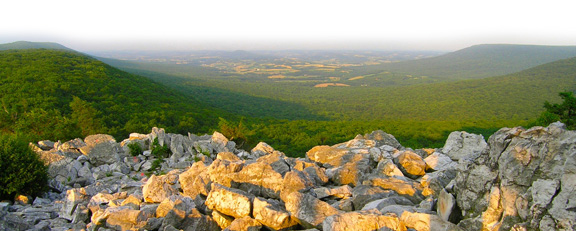Hawk Mountain
More than a century ago many people believed the only good hawk was a dead hawk. Even bird lovers and conservationists detested hawks.
The Pennsylvania Game Commission, fearing certain bird-killing hawks would wipe out the ruffed grouse population, offered a $5 bounty per goshawk in the 1930s. During the Great Depression that was a mighty sum and hunters lined up to take aim. They weren’t selective; they shot at all hawks. Gunshot thundered above the ridges of Hawk Mountain in the predator control program.
With fewer hawks patrolling their fields, farmers complained mice and other varmints, the usual target of these birds of prey, were costing millions in crop damage and destroying nature’s balance.
Realizing the enormity of the slaughter and its far-reaching effects, a few dedicated conservationists, led by Richard Hooper Plough and Rosalie Edge, worked hard to stop it. As a result of that labor Edge founded Hawk Mountain Sanctuary in 1934 and a year later leased 1,373 acres of the mountain as a private sanctuary.
What had been a killing field became a haven for birds of prey, the first of its kind in the world. The sanctuary has since doubled in acreage and the scientific research done there has spread around the globe.
Hawk Mountain became the prime battlefield for that long-ago crusade because it attracts hawks, eagles and falcons migrating from Canada over the mountain, part of the Kittatinny Ridge of the Appalachians. Traveling raptors ride thermals, the warm updrafts over the mountain, which allow them to rest their wings as they journey south.
Hawk Mountain is one of the best places in North America to view annual hawk migrations. The raptors arrive by the thousands from late August through December – and so do raptor enthusiasts who climb the sanctuary trails and settle on the rocks at lookout points to scan the sky with binoculars or take photos. They see – and count – not just birds of prey but hummingbirds, chimney swifts, butterflies, blue jays, ravens, goldfinches and juncos.
Hawk Mountain Sanctuary hosts 60,000 to 70,000 visitors a year, according to Mary Linkevich, director of communications and grants. The majority comes during the autumn months when the most avian activity takes place; however, Hawk Mountain is a wildlife sanctuary open to the public year-round, she said. It has become an eco-tourism destination with visitors from around the world and a learning center – “a school in the clouds” – for all ages.
It is a great place to visit for day trips with its eight miles of hiking trails. It’s also a place to learn, and perhaps most important of all, a place for scientific research. Linkevich said Hawk Mountain Sanctuary Association is the world’s largest member-supported raptor conservation organization.
Even in the dead of winter the wildlife viewing windows in the handsome Visitors Center are alive with small birds and mammals that winter there. The center also houses conservation exhibits, the Mountain Book Store, a nature gift shop and a native plant garden.
The 11-year-old Acopian Center for Conservation Learning is a biological station and training center. It was the gift of the late Sarkis Acopian, an inventor, industrialist, environmentalist and humanitarian who immigrated from Iran in 1945 and earned a mechanical engineering degree at Lafayette College.
Thanks to his generosity, environmental students from all over the world – countries such as, Spain, England, Germany Armenia, Estonia, Ethiopia, Venezuela, Peru, Kenya, Nigeria, Mongolia and Nepal, have served as interns at the Acopian Center. They spend three months there, living and learning, working with the Hawk Mountain research team, headed by Dr. Keith Bildstein, studying migration patterns and monitoring changes in raptor populations. They take their newfound knowledge to their homelands where they work with raptor conservation programs.
Monitoring raptors is important on a global scale. It basically serves as an environmental early warning system. The birds are sensitive bio-indicators at the tops of food chains, and increasing or decreasing numbers of raptors reflect changes in the state of the environment, according to Linkevich.
The sanctuary is registered as a National Natural Landmark. Linkevich said the non-profit association is entirely self-sufficient, “with membership and trail fees our most reliable source of revenue.” Annual membership fees range from $35 to $250, and trail fees are a modest $6 or less. Other funding is obtained from grants and individual and corporate gifts.
Major fund-raising events coming up this spring include the gala Benefit for Birds and a native plant sale. The Benefit for Birds will take place May 10 at Bear Creek Resort and Conference Center in Macungie. The fun-filled benefit will feature live birds, a silent auction, open bar and sit-down dinner. Tickets are $130 per person. The native plant sale is scheduled May 18 from 10 a.m. until 4 p.m. in the parking lot at the sanctuary’s Visitor Center.
The sanctuary will participate in the Annual Hawk Mountain Arts Tour and Sale on June 1. It’s a free self-guided driving tour of the studios of more than a dozen artists and artisans who live and work in the scenic Kempton Valley but whose reputations spread beyond.
The sanctuary is open daily throughout the year with extended hours in the warmer months. Trails are open dawn to dusk.
More information is available at hawkmountain.org.





